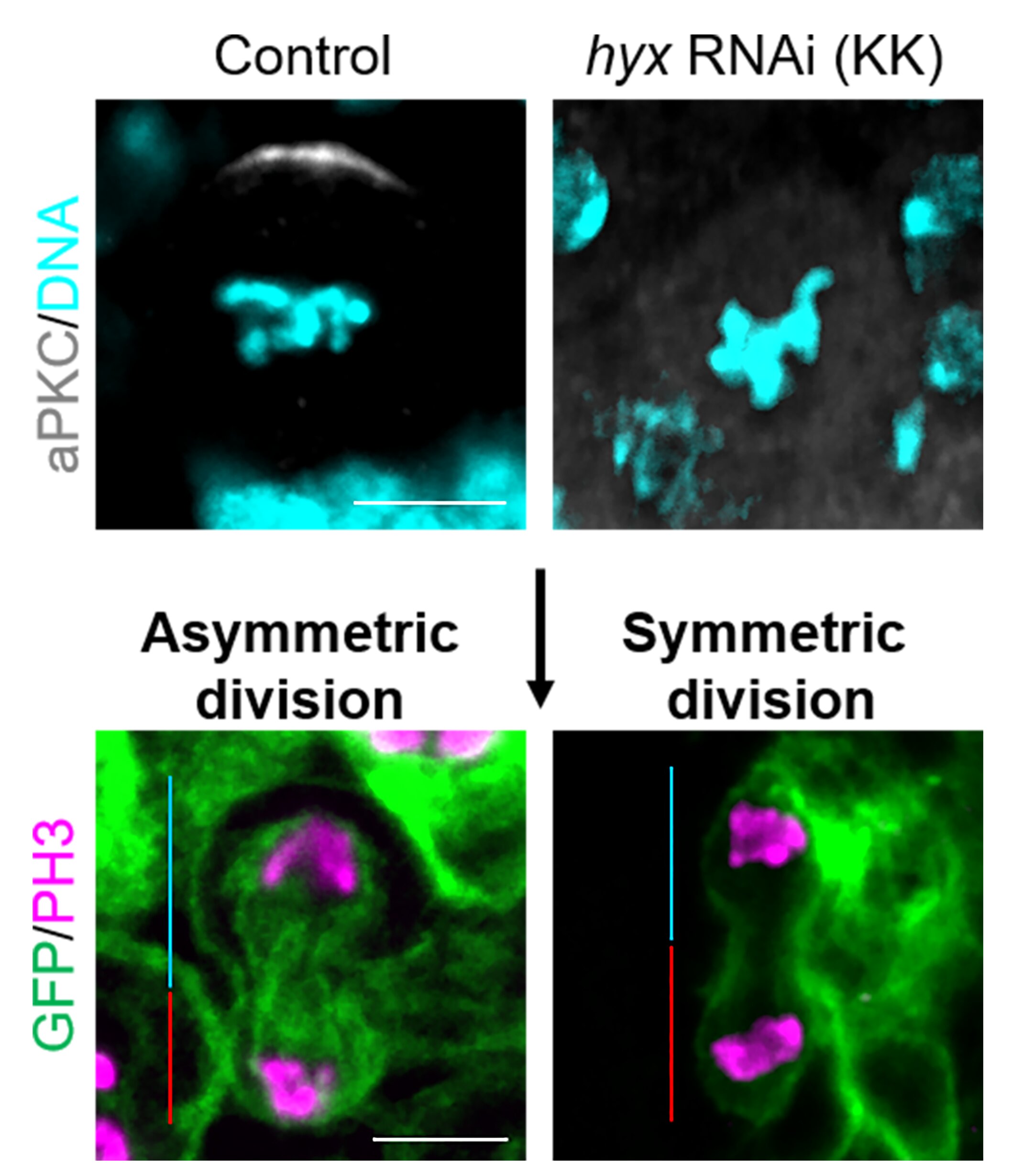Loss of parafibromin/hyrax leads to loss of neural stem cell (NSC) polarity, resulting in a switch from asymmetric to symmetric division. Upper panels: Dividing NSCs from control (left) and hyrax knockdown (right) were labeled with a cell polarity protein aPKC (grey) and DNA (cyan). The asymmetric localization of aPKC is lost upon knockdown. Lower panels: Telophase brain-derived NSCs were tagged with a mitotic marker phospho-histone H3 (PH3 in magenta) and a membrane marker GFP (green), which marks the cell outline. Blue lines and red lines indicate the diameter of two daughter cells of NPCs. Control NSC (left) divides asymmetrically to produce two different-sized daughter cells, while hyrax knockdown NSC (right) divides symmetrically to produce two similar-sized daughter cells. Scale bar: 5 mm. Photo credit: Duke-NUS
Scientists in Singapore and Spain have gained new insight into the activity of a tumor suppressor protein in fruit flies that could help understand some human cancers. The study, published in PLOS biologycould eventually lead researchers to new cancer treatments and prevention.
Scientists from Duke-NUS Medical School collaborated with colleagues from the Barcelona Institute of Science and Technology Institute for Biomedical Research, the Genome Institute of Singapore and NUS to study a human tumor suppressor protein called parafibromin. Parafibromin’s normal activities prevent tumors from developing, but deficiencies in these activities have been linked to several types of cancer, including hyperparathyroidism-jaw tumor syndrome and breast, stomach, colon, and lung cancers. Until now, the exact role of the protein in health and disease in the nervous system was unknown.
Although fruit flies and humans appear to be very different, researchers often find that important molecular signaling pathways, signaling and control systems are shared by many species and arose early in the evolution of a variety of organisms.
“Since hyrax – an evolutionarily related protein – is the analogue of parafibromin, we examined it in developing brain cells in Drosophila fruit flies as a first step towards a better understanding,” said Dr. Deng Qiannan, first author of the study and a research fellow with the Neuroscience and Behavioral Disorders (NBD) program at Duke-NUS.
“We have discovered that the hyrax protein plays an essential role in the development of the Drosophila central nervous system, and therefore we believe parafibromin may serve a similar function in humans,” said Dr. Cayetano Gonzalez, a co-author of the study and head of the cell division laboratory at the Institute for Biomedical Research, Barcelona.
The results revealed previously undiscovered roles of the protein in controlling cell polarity – the asymmetric organization of proteins – in the stem cells that give rise to mature neurons. Loss of hyrax function has been found to lead to overgrowth of neural stem cells in the Drosophila brain. This has been linked to influences on cell structures called centrosomes, which coordinate cell division, and the regulation of two other known tumor suppressor proteins, polo and aurora-A kinases.
“Loss of cell polarity and centrosomal abnormalities are hallmarks of human cancers,” said Professor Wang Hongyan, the study’s senior author and associate director of the NBD program at Duke-NUS. “These surprising new findings could be very relevant for understanding the role of parafibromin in human cancers, perhaps particularly in the brain.”
More research is needed to investigate whether these results in fruit flies can be applied to parafibromin in humans, and the research team has already started new investigations towards this goal.
“Translating basic scientific research into discoveries of clinical importance is a primary goal of medical research. Professor Wang and her colleagues have taken a very interesting first step that could one day have implications for cancer treatment and prevention,” said Professor Patrick Casey, Senior Associate Dean for Research at Duke-NUS.
Proteins resist the regression of nerve cells
Qiannan Deng et al, Parafibromin regulates cell polarity and centrosome assembly in Drosophila neural stem cells, PLOS biology (2022). DOI: 10.1371/journal.pbio.3001834
Provided by Duke-NUS Medical School
Citation: Learning about human cancer from fruit flies (2022, October 19), retrieved October 19, 2022 from https://phys.org/news/2022-10-human-cancer-fruit-flies.html
This document is protected by copyright. Except for fair trade for the purpose of private study or research, no part may be reproduced without written permission. The content is for informational purposes only.
#Learning #human #cancer #fruit #flies


Leave a Comment